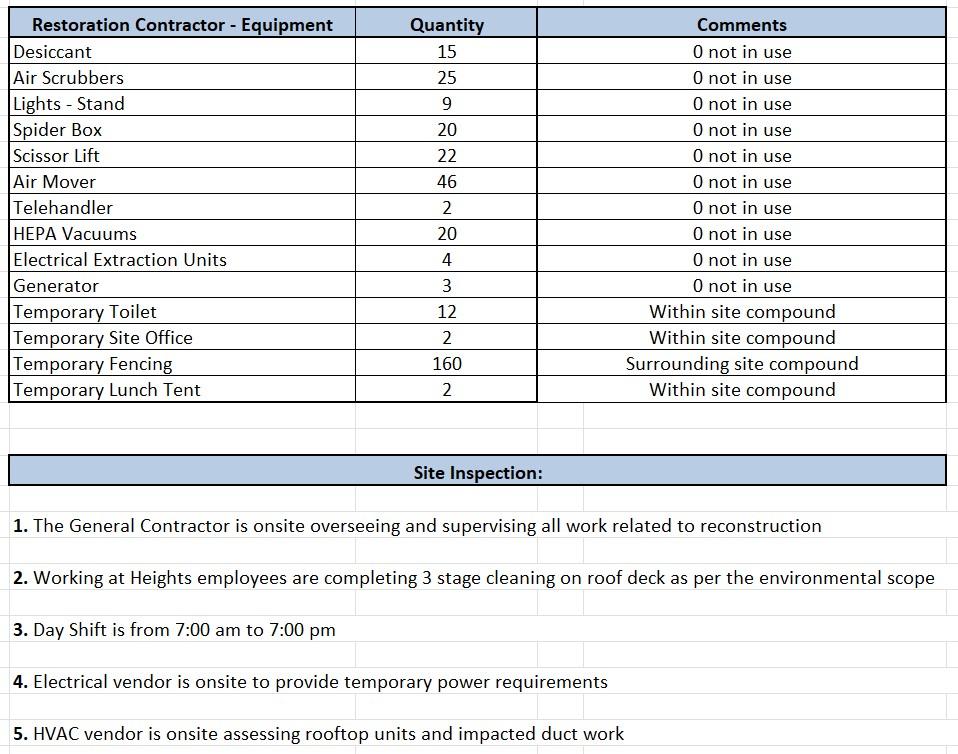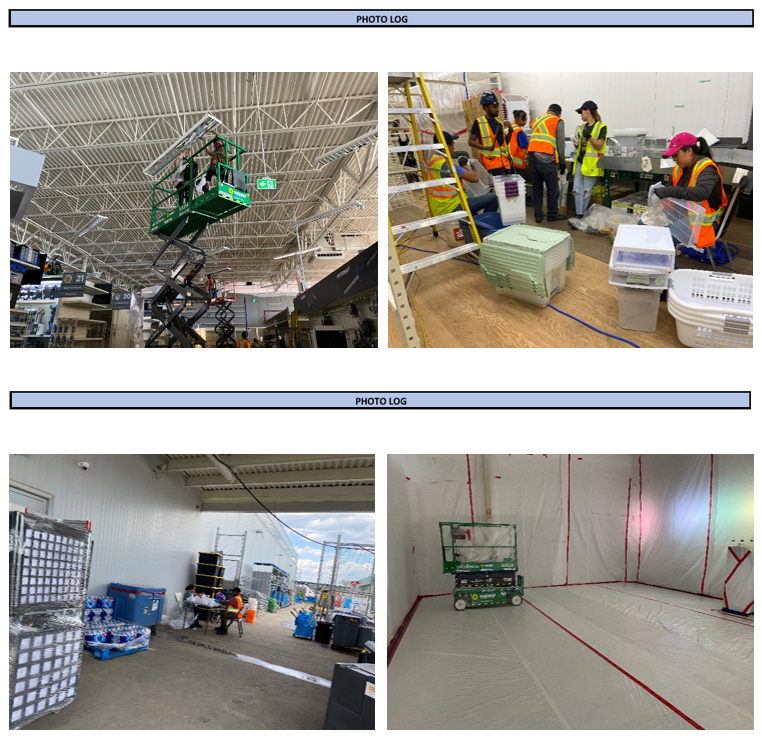[author: Jason Worrall]
Meta Description: Learn about the significance of project monitors in the construction industry. Understand their role, daily tasks, and impact on ensuring accuracy, value, and timeliness toward project completion.
Introduction
Project monitoring has a vital role in both large-scale remediation and/or construction sites and smaller claims by providing the insurers valuable insight and project oversight. The potential for a large time and expense invoice or an extended production schedule is monitored closely to ensure accuracy and to foreshadow upcoming project challenges that may lead to additional financial exposure.
The goal of a project monitor is to have a complete understanding of the scope of work by:
- Assessing the loss.
- Quickly navigating equipment and workforce resource requirements.
- Ensuring the equipment and workforce are appropriate to the project at hand.
- Providing on-site, real-time evaluations.
- Working with the assigned restoration vendors and all applicable consultants to flag and address potential delays within the required scope of work.
- Recommending and monitoring fair and reasonable expenditures per client expectations.
- Site presence during the emergency phase of the loss.
Consistent site presence is crucial during the emergency phase of an insurance claim as well as open communication with both the restoration vendor completing the necessary scope of work, and the client. The project monitor routinely remains onsite for the duration of the emergency phase as the “eyes and ears” of a third party, reporting on the equipment, labor, materials, and workmanship. They will monitor progressions and delays while reporting their findings to the client, as these factors significantly impact the project’s budget and completion schedules. Project monitors utilize their expertise in the field to assist and provide the client with an “inside look” at the day-to-day operations being completed to restore the loss location to its pre-loss condition.
Role of a Project Monitor
The role of the project monitor, while not limited to these items, includes the following:
Daily Reporting Detail: Key Aspects of Day-to-Day Monitoring
- Construction site conditions.
- Conditions (weather, temperature, precipitation, etc.) may cause a schedule interruption depending on the project and task or add to workplace hazards. As an example, strong wind conditions would affect the operation of a crane and subsequent lifts, thereby delaying that day’s production and the overall project. Ice or snow may inhibit the ability to complete a task safely, causing the contractor to pivot and make necessary site adjustments.
- Labor counts and varying trades (Fig. 1).
- Different projects require different labor and trade involvement; having enough workers onsite to complete the task is key, and having too many workers can be counterproductive, inefficient, and add unnecessary expense.
- Collaborating with the assigned contractor to ensure there is adequate site supervision to organize labor and assets is critical to a successful project.
- Daily onsite headcounts of each trade specialty and their designation are recorded. This information is important when discussing productivity and crew ratios and will be of use during invoice review.

Figure 1 - Daily labor report (excerpt).
- Material deliveries.
- As with labor, each project will require specialty materials and consumables based on the required scope of work. Ensuring that the contractor deploys the correct materials and consumables to the site is critical to having a productive project. Collecting records of material and consumable inventories, as well as deliveries, will assist in the invoice assessment and ensure accuracy.
- Equipment deliveries, removals, and daily onsite count (Fig. 2).
- Projects typically require site-specific equipment. Typically, the expense of equipment begins the moment it arrives onsite. It is important to know what equipment is required, the quantity, and the duration for which it will be onsite. Project monitors pay special attention to ensuring that the on-site equipment is required and in use daily. Having dehumidifiers, air movers, desiccants, generators, forklifts, or even a crane onsite and not in use is an opportunity for discussion and negotiation—no matter the size of the equipment or the project.
- Equipment counts, inventory, and usage are taken daily.
- Daily site observations (Fig. 2).
- Daily observations—per trade, are taken as a record of job progressions or interruptions depending on the situation.
- These observations are available to the client for review and to act as a progress update for daily site activities.

Figure 2 - Daily equipment and activity (excerpt).
- Photo documentation of site progression (Fig. 3).
- Onsite photos of equipment, labor, and various other details, whether considered relevant or not at the time, are taken daily. Photos are an excellent indicator of project progressions or delays and provide clients with an opportunity to observe daily site conditions.
- Virtual 360° walkthroughs during the emergency phase of the insurance claim allow clients and applicable parties to inspect all aspects of the site without having to be physically on-site. Phases can be captured throughout the project to provide valuable insight into the progress and scheduling milestones and provide the ability to see “before” and “after”. 360° photographs of the site at the beginning of the insurance claim can also be used to capture the pre-loss condition and to aid in establishing the restoration scope or status of construction.

Figure 3 - Photo progressions.
Review of Contractor Rate Sheets: Understanding and Evaluating Contractor Pricing
- A rate sheet is used by restoration contractors as a calculation of costs such as labor (regular working hours, overtime, and potential night shifts), vendor/subcontractor (regular working hours, overtime, and potential night shifts), equipment rental rates, tools, consumables, etc. The rate sheets should be reviewed and negotiated at the beginning of each project, including crew/supervision ratios and clarification of any vague or hidden fees.
- A discussion of concerns and agreed-upon rates is vital as it will become the “agreed to” at the end of the emergency phase and invoice review. Open communication amongst all parties at the beginning of the project is crucial to having a successful, well-managed, and productive project.
Monitor Daily Consumables: Tracking and Assessing Daily Material Consumption
- Knowing the daily consumable usage will assist with knowing a crucial element associated with the contractor's “burn rate,” especially on a mitigation project.
- Daily monitoring of consumables allows insight into productivity and provides an opportunity to foreshadow potential delays or inefficiencies.
Daily Contractor Meetings: Establishing Regular Communications with Contractors
- At the onset of any project, it is vital to establish open communication and ensure all parties’ expectations are identified and managed.
- Daily update meetings with contractors allow the project monitor to ensure goals are being met and realistic timelines are established.
- As the project progresses these meetings become important to prevent delays and bottlenecks on site which may lead to scheduling delays or increase financial exposure.
Developing a Working Relationship with the Restoration Contractor & Insured
- Building a working relationship with the vendors on the project is important as mutual respect is required amongst all parties to be successful.
- Addressing questions and concerns with the contractor daily is vital to providing clients with valuable insight and preventing future issues.
- Never give direction; however, when required, it is important to challenge the direction given.
- There are opportunities to work alongside the contractor. For example, clarifying what is considered loss-related damage and repairs versus what would be considered an improvement.
Attend Contractor and Insured/Owner Meetings
- The insured’s knowledge of the project progressions or delays is essential information delivered by the contractor and observed by the project monitor. These meetings provide valuable insight into the project monitor and assist with understanding if there is potential direction being given to the contractor by an owner or their representative.
Audit Contractor Invoices
- Contractor invoices for payment on larger projects are typically progressive. The values and rates for labor, equipment, tools, consumables, etc., that were “agreed to” at the beginning of the project through a rate schedule assessment will now be implemented.
- The project monitor has firsthand knowledge and reporting of daily site activity, which will offer insight into the verification of contractor invoicing.
- Field notes, photographs, and meeting minutes collected throughout the duration of the project are utilized to ensure accuracy within the invoice packages submitted by the contractor.
Address Unresolved Concerns Affecting Project Completion
- When a project is approaching completion, and the catastrophic mitigation has subsided, so begins the detail of cleaning and finalizing punch lists. This is the time for the project monitor to stay extra vigilant as these are the details that can keep a job from timely completion.
Conclusion
Today’s project monitor provides an independent assessment of the project at hand with the experience, knowledge, and understanding of most building processes. Whatever the size of the project—from mitigating a water loss in a large commercial site to a single-family home—the project monitor builds a strong working rapport with the restoration contractor, insured, and the various vendors engaged to assist with the insurance claim. Project monitoring plays a vital role in all insurance claims by providing the insurers with valuable insight and project oversight.